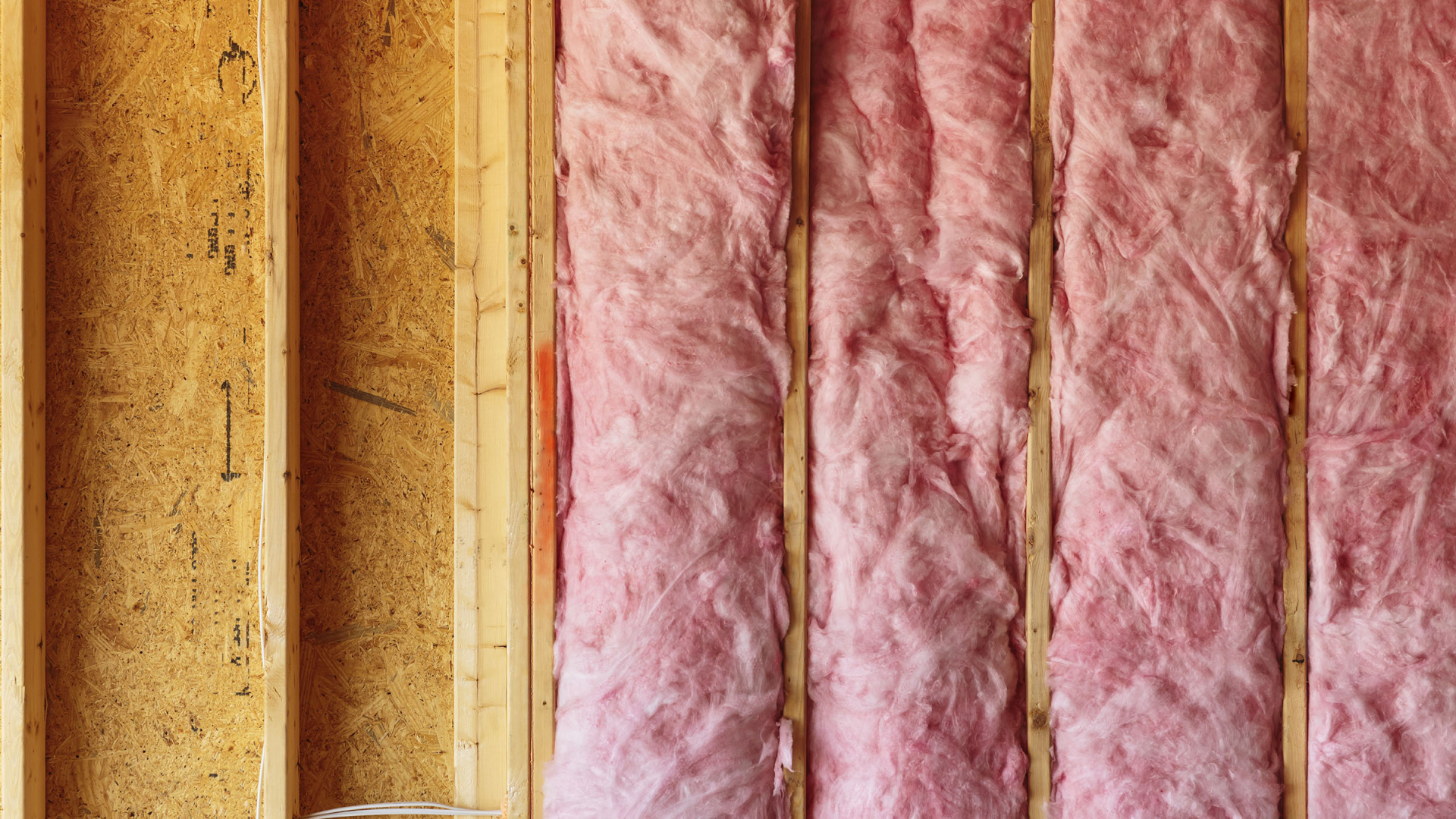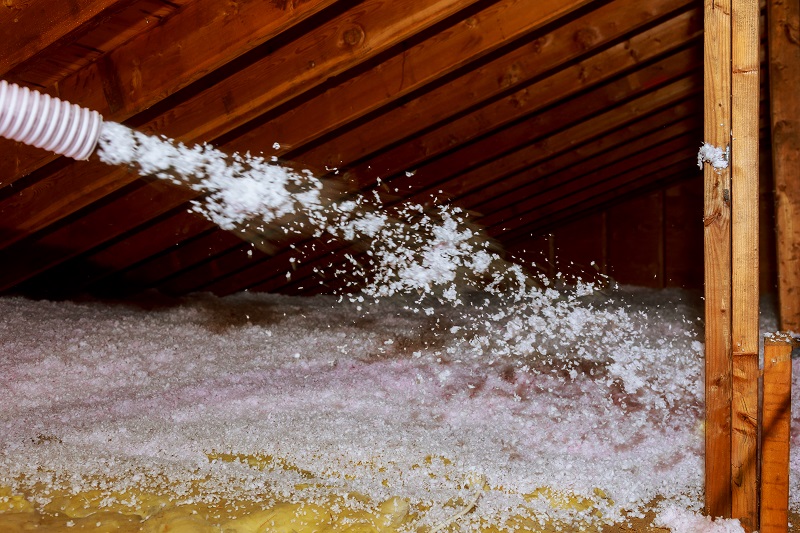
Spray foam helps reduce noise in busy commercial spaces by sealing air gaps and absorbing sound waves. Applying to walls, ceilings, and other surfaces creates a barrier that stops sound from moving between rooms and floors. Most businesses see a 50-80% reduction in noise after proper spray foam installation, making the workspace quieter and more productive.
In today’s busy commercial settings, noise control is vital for worker focus, customer comfort, and overall business success. This guide shows how spray foam insulation tackles noise problems in offices, restaurants, retail stores, and other commercial spaces.
How Spray Foam Reduces Noise
Spray foam works in two main ways to lower noise levels in commercial buildings:
Sound Absorption
Spray foam catches sound waves and turns them into tiny amounts of heat energy instead of letting them bounce around a room. This helps reduce:
- Echo and reverberation
- Background noise
- Sound from equipment
- Voice carry-over in open spaces
Sound Blocking
Spray foam also stops sound from traveling between spaces by:
- Sealing tiny cracks and gaps
- Creating a solid barrier between rooms
- Blocking airborne noise transmission
- Reducing structure-borne vibrations

Types of Spray Foam for Noise Reduction
Different kinds of spray foam offer various noise reduction benefits:
| Type | Noise Reduction Coefficient (NRC) | Sound Transmission Class (STC) Improvement | Best For | Cost Range (per sq ft) |
|---|---|---|---|---|
| Open-Cell | 0.70-0.80 | 5-10 points | Sound absorption, interior walls, echo reduction | $1.50-$2.50 |
| Closed-Cell | 0.50-0.60 | 8-12 points | Sound blocking, exterior noise, mechanical rooms | $2.00-$3.50 |
| Specialty Acoustic | 0.75-0.95 | 10-15 points | Recording studios, theaters, conference rooms | $3.00-$5.00 |
Open-Cell Spray Foam
Open-cell foam has a spongy structure that works well for absorbing sound within a space.
- Traps air in small, connected pockets
- More flexible and less dense
- Better for catching and reducing sound waves inside a room
- More affordable option
Bonus Tip: Open-cell foam is perfect for reducing echo in large open spaces like gymnasiums, cafeterias, and open office layouts.
Closed-Cell Spray Foam
Closed-cell foam has a denser structure that blocks sound from moving between spaces.
- Contains tiny bubbles that don’t connect
- Creates a more solid barrier
- Better at stopping outside noise from entering
- Also provides moisture protection
Bonus Tip: Use closed-cell foam in exterior walls to block street noise, in mechanical rooms to contain equipment sounds, or in floors to reduce footstep noise between levels.
Common Commercial Applications
Spray foam noise reduction works well in many commercial settings:
Offices and Call Centers
Applied in walls between offices and conference rooms, spray foam creates private spaces for meetings and sensitive conversations. Recent market data shows that offices with proper acoustic treatment see a 27% increase in worker productivity and 37% fewer reported distractions.
Restaurants and Retail
Spray foam helps create a more pleasant dining or shopping experience by:
- Reducing kitchen noise in dining areas
- Lowering the overall noise level to make conversation easier
- Creating a more comfortable shopping environment
- Preventing noise from bothering neighboring businesses
Hotels and Hospitality
In the hospitality industry, spray foam insulation helps:
- Block noise between guest rooms
- Reduce hallway noise
- Quiet mechanical systems like elevators and HVAC
- Create peaceful sleeping environments

Medical Facilities
Healthcare settings benefit from spray foam’s ability to:
- Ensure patient privacy by reducing sound transfer
- Create quiet recovery environments
- Minimize distracting equipment noise
- Meet HIPAA requirements for confidentiality
Installation Process in Commercial Settings
Installing spray foam for noise reduction typically follows these steps:
- Assessment: Identifying problem areas and noise sources
- Preparation: Clearing the area and covering surfaces not being treated
- Application: Spraying the foam into wall cavities, ceilings, or other areas
- Curing: Allowing 24-48 hours for the foam to fully set
- Finishing: Adding drywall or other coverings over the foam
| Installation Factor | Timeframe | Business Impact |
|---|---|---|
| Installation Time | 1-3 days for most projects | Business closure or section closure required |
| Curing Period | 24-48 hours | Ventilation needed, limited access |
| Return to Normal Use | 2-4 days total | Plan for weekend work or slow periods |
Things to Consider Before Making a Decision
Before choosing spray foam for noise reduction in your commercial space, think about:
Noise Problem Assessment
First, identify exactly what kind of noise issues you’re facing:
- Is noise coming from outside the building?
- Is sound traveling between rooms?
- Is there too much echo within spaces?
- Are specific pieces of equipment causing problems?
Different noise problems require different solutions, and spray foam might be just one part of a complete noise control plan.
Building Codes and Regulations
Commercial buildings must meet certain requirements:
- Fire safety codes for insulation materials
- Local building regulations
- OSHA workplace noise standards
- ADA considerations for accessibility
Cost vs. Return on Investment
While spray foam costs more upfront than some other noise reduction methods, it often provides better long-term value:
| Solution | Initial Cost | Lifespan | Maintenance Needed | Additional Benefits |
|---|---|---|---|---|
| Spray Foam | $$$$ | 20+ years | Minimal | Energy savings, moisture control |
| Acoustic Panels | $$ | 5-10 years | Periodic replacement | Decorative options |
| Drop Ceilings | $$$ | 10-15 years | Occasional tile replacement | Easy access to utilities |
| Mass-Loaded Vinyl | $$ | 15+ years | May need reapplication | Thin profile |
Common Questions About Spray Foam Noise Reduction
How much noise reduction can I really expect?
The amount of noise reduction depends on:
- The type of foam used
- How completely the space is treated
- The original construction of the building
- The frequency of the noise (high or low pitch)
Most commercial projects see a 50-80% perceived noise reduction when spray foam is part of a complete noise control strategy.
Can spray foam be added to existing buildings?
Yes, spray foam can be added to existing commercial buildings. Installation typically requires:
- Opening up walls by removing drywall
- Spraying foam into cavities
- Replacing drywall and finishing surfaces
Some spaces may allow for application through small holes that are patched afterward.
Spray Foam Noise Reduction FAQ
Is spray foam fire-safe for commercial buildings?
Most commercial-grade spray foam products include fire retardants and meet building codes when properly installed. Always check that the product has appropriate fire ratings for commercial use.
How long does spray foam noise reduction last?
Properly installed spray foam maintains its noise reduction properties for the life of the building (20+ years) without degradation or maintenance.
Can spray foam reduce all types of noise?
Spray foam works best for airborne noise (voices, music, etc.). It helps less with impact noise (footsteps, dropped items) and low-frequency sounds (bass, machinery vibration). For complete noise control, combine spray foam with other solutions like mass-loaded barriers or vibration isolators.
Will spray foam noise reduction work if only applied to some areas?
Sound follows the path of least resistance. For best results, all potential sound paths need treatment. Partial application will show some improvement but may not solve the entire noise problem.
Does spray foam smell after installation?
Spray foam may have a noticeable odor during installation and curing (24-48 hours), but properly installed foam has no smell once fully cured.
Make the Right Decision
Spray foam offers an effective solution for reducing noise in busy commercial environments. It provides long-lasting noise control while also improving energy efficiency and moisture management.
Assess your specific noise problems, building structure, and budget before deciding. For most commercial settings, the initial investment pays off through improved worker productivity, customer satisfaction, and reduced energy costs. Consider working with an acoustic consultant to develop a complete noise control plan that might include spray foam along with other targeted solutions.
